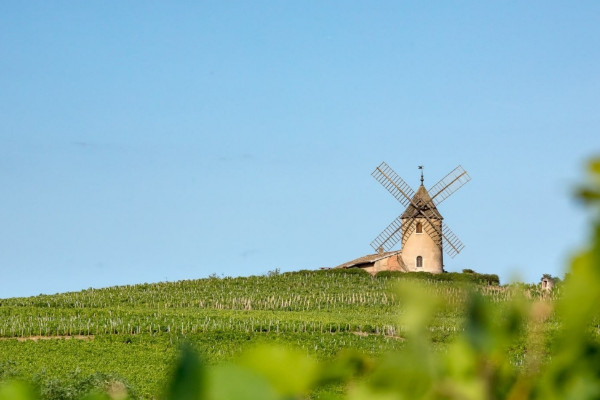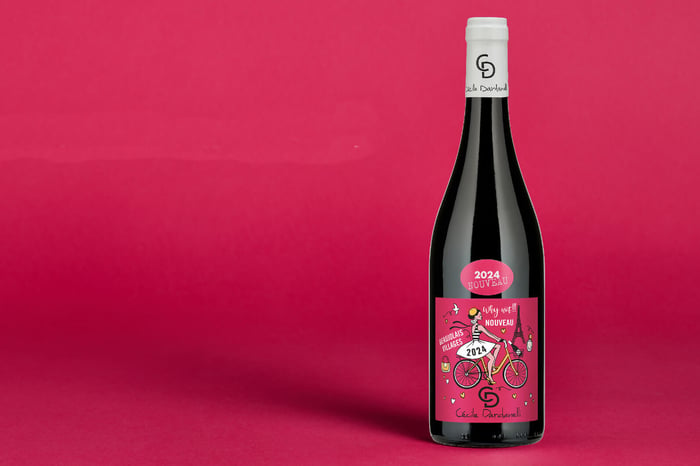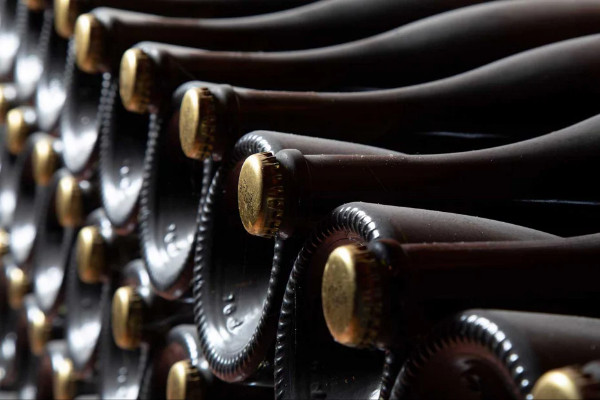
A guide to Beaujolais wine
Table of Contents
I have been lucky enough to travel to Beaujolais and to share wine with the winemakers, many of whose families have worked the hilly vineyards for generations. Just like their wines, the vignerons are often easy-going, charming, and bursting with youthful energy.
In this article let me guide you around this historic region.
Discover our range of Beaujolais wines online
A Brief History

This is a region that has drifted in and out of fashion.
During the Gallic Wars the Romans realised the potential of the region and many of the villages can trace their names back to Roman soldiers who chose to settle here.
In the Middle Ages subsequent rulers flip-flopped between loving and hating Beaujolais. King Louis XIII would only serve Beaujolais wine at his table, whilst the Duke of Burgundy, Philip the Bold, decreed that all the Gamay vines must be ripped up.
At the start of the 20th century cru Beaujolais wines were held in the same prestige as those from Burgundy. At auction in 1932 it cost the same to buy 1 hectare in Morgon as it did to buy 1 hectare in Burgundy. Now, land in Burgundy can be 300 times more expensive.
In the 1990s Beaujolais Nouveau was a household name. Yet by the early noughties it was deemed passé.
Today, the regional wine council is championing the unique terroir of the region and once again it is on the up.
There is no better time to discover Beaujolais.
Where is Beaujolais?
The vineyards stretch north to south over 55 kilometres, bordered to the west by the foothills of the Massif Central, and to the east by the Saône river. The vines are planted on gently rolling hills and on a good day you can see the distant alps and the towering peak of Mont Blanc.

The vineyards boast forests, plains, and winding roads. The region is green, varied, lush and inspiring. In the north the vista is dominated by mountains, whilst in the south the glowing golden stones of the Pierres Dorées are reminiscent of Tuscany.
The region is subject to France’s three main climatic influences: continental currents, oceanic air movements and Mediterranean winds. The climate is temperate (11.5°C on average) with significant differences from summer to winter.
The Haut-Beaujolais mountain range, reaching 1000 metres in altitude, plays a protective role by sheltering the vineyard while the Saône river regulates the temperature differences.
What is Beaujolais?
Beaujolais is a “single grape variety” region. Rosé and red wines are made from Gamay, whilst Chardonnay is the only permitted variety for white wines.
The largest appellation is AOC Beaujolais, covering all 96 communes in the region. Reds, rosés and white can all be made in this classification.
One step up in quality is AOC Beaujolais-Villages. This appellation is located in the northern part of the region and covers 38 villages. Again, it is permitted to make reds, rosés, and whites.
Whites are labelled as Beaujolais Blanc and they are a great value alternative to whites from Burgundy. Chardonnay vines are found mostly in the north, bordering Burgundy's Mâconnais, and in some instances winemakers can choose to classify their grapes as either Bourgonge Blanc or Beaujolais Blanc.
White grapes cannot exceed 15% of a vineyard, so volume will always be limited, and white wine currently accounts for just 2% of production.
The ten cru Beaujolais villages (see below) are only permitted to make red wines.

Gamay, or to give it its full name Gamay Noir À Jus Blanc, has been the main grape planted in the vineyards since the 17th century. The predominance of granite bedrock has proved to be the perfect foundation for the grape variety to develop finesse and a diverse expression.
Gamay is a cross between Gouais Blanc and Pinot Noir. It is thin-skinned, though more adaptable than Pinot Noir (fun fact although a white grape, Chardonnay is also a cross between Gouais Blanc and Pinot Noir). Its grapes are cylindrical, compact, and surrounded by flat, even-edged leaves. Once found throughout France with over 160,000 hectares planted, the remaining 30,000 hectares are mostly in Beaujolais.
The Gamay grape has a natural exuberance, which the winegrowers of the Beaujolais region have learned to tame to bring out its best qualities. Gamay wine is lively and bright with predominantly fruity flavours of raspberry, wild strawberry, blackberry, and black cherry, sometimes with peppery and floral notes.
Manual harvesting still accounts for most of the harvesting. In the crus the low vines and steep slopes make mechanical harvesting almost impossible.
What is Beaujolais Nouveau?
For centuries, St Martins Day festival, which falls on 11 November, celebrated the end of the wine growing year and the release of the “new wine”. In 1951 the people of Beaujolais started to commercialise this tradition by selling Beaujolais Nouveau to the bistros of Lyon.
Thanks to the efforts of George Dubœuf, often nicknamed “the Pope of Beaujolais”, Beaujolais Nouveau became a big hit around the world. In 1985 the French government designated the third Thursday in November as Beaujolais Nouveau Day.
The early 1990s saw the trend expand to North America, Eastern Europe, Japan, and China. The peak came in 1992 when over half the production of the region was Beaujolais Nouveau. Mass production and declining quality inevitably led to declining sales.
Beaujolais Nouveau remains important to the region though, and refocussing on quality has seen a return to popularity. Beaujolais Nouveau now accounts for around 20% of total production and millions of people gather every November to celebrate their taste for the good life!
This year celebrate Beaujolais Nouveau Day on 21 November 2024 .
Making quality Nouveau wine relies on the talent and know-how of the winemakers. The wines are made using carbonic or semi-carbonic maceration (see below). If the maceration vat is run off too soon, the wine will be too lightweight and colourless. On the other hand, if done too late, the tannins will be too harsh. The goal is to achieve a wine for pure pleasure, one without astringency, which is delicate, refreshing and fruity.
What is Carbonic Maceration?

Traditional Beaujolais is generally fruity, aromatic, and crisp. The style is attributed to carbonic or semi-carbonic maceration.
The process starts with whole bunches being placed in a vat or tank. To maintain the integrity of the berries there is no de-stemming. At the bottom of the vat, the berries release their juice, and a yeast-induced fermentation starts.
This alcoholic fermentation releases carbon dioxide which induces an anaerobic process in the intact berries at the top of the vat. The anaerobic respiration leads to a build-up of ethanol and lactic acid in the grapes. This causes them to break down and release their juices.
Unlike traditional winemaking, where grapes are crushed and the juice is extracted before fermentation, carbonic maceration allows the grapes to ferment inside their skins. This method results in a wine with less tannin and more fruit-forward flavours since the skins don't have as much contact with the fermenting juice.
After the initial carbonic maceration phase, the wine is typically pressed to extract the remaining juice. The press juice and free-run juice are then combined in the vat to finish off the alcoholic fermentation. The result is a wine with a lighter colour, lower tannins, and higher levels of fruity aromas and flavours, compared to wines made using traditional fermentation methods.
What Are the Ten Crus?
The 10 Beaujolais cru villages follow the course of the Saône river. Starting in the south, first comes Brouilly and Côte de Brouilly, then Régnié, Morgon, Chiroubles, Fleurie, Moulin-à-Vent, Chénas, Julinénas and finally Saint-Amour. Each is an appellation offering red wines made from 100% Gamay (the only permitted grape variety).
Cru Beaujolais is a serious wine which deserves a place in everyone's cellar.
AOC Brouilly
Brouilly is the southernmost and most extensive of the crus. It stretches out over the communes of Quincié-en-Beaujolais, Saint-Etienne-la-Varenne, Charentay, Saint-Lager and Cercié. The vines grow on slopes from altitudes of 195m to 525m.
The name Brouilly comes from Brulius, a lieutenant in the Roman army. He received the hill as a reward for winning many battles. After settling here, he gave the hill his name. As an officer of the imperial legion under Julius Caesar, Brulius lived on the hill and decided to make the most of its outstanding sunshine by planting vines.
Brouilly wines are dazzling due to their ruby red colour, more purplish when from the granitic terroirs and darker when from the eastern alluvial area. Their dominant fruit aromas are strawberry and raspberry.
There are many lieux-dits within the appellation, which are named areas of a vineyard from which the best fruit comes. These include: Saburin, Pissevielle, Briante, Pierreux, Combiaty, Les Platures, Les Nazins, La Roche, Les Bruyères, and La Terrière.
AOC Côte de Brouilly
The Côte de Brouilly appellation covers four communes at the summit and on the slopes of Mont Brouilly: Saint-Lager, Odenas, Quincié-en-Beaujolais and Cercié.
La Chapelle du Mont Brouilly is the emblem of the appellation. After hail, frost and powdery mildew devastated the vineyard in 1850 and 1852, the growers built the chapel to protect their vines.
Intense garnet red in colour, Côte de Brouilly wines offer a complex range of aromas, from red fruits, to plums, floral fragrances, and pepper. On the palate, they are vibrant and structured. The hill’s underlying geology is mostly blue stones created by ancient underwater volcanism. These stones, plus sunshine, are conducive to the development of tannins and endow the wines with a powerful, mineral, and spicy character.
The lieux-dits include: Chardignon, L’Héronde, Croix Dessaigne, Brouilly, Chavennes, Le Pavé, Godefroy, Berthaudières, Gilets, and Côte de Brouilly.
AOC Régnié
Régnié became the newest of the ten crus when it was created in 1988. It stretches over the commune of Régnié-Durette, with a few hectares in Lantignié. The village of Régnié is especially noteworthy for its church that has two spires. It was built in 1867 from plans by Pierre Bossan, the architect who later built the Basilica of Notre-Dame de Fourvière in Lyon.
Vines have grown on the slopes of Régnié-Durette since Roman times. The remains of a Gallo-Roman villa have been uncovered in Régnié, which belonged to Reginus, a Roman nobleman who bestowed his name on the commune.
Régnié wines are bright red, like a perfectly ripe cherry. They typically have bright red flavours of wild strawberries and raspberries.
The permitted lieux-dits include Basse Ronze, La Haute Plaigne, Les Chastys, Vallières, La Pierre, Les Reyssiers, Aux Bruyères, Oeillat, Croix Penet, and Les Bois.
AOC Morgon
Morgon is a cru that extends over a large area, second only in size to Brouilly. It is centred on Villié-Morgon the largest wine growing commune in the region. It is overlooked by the mythical Mont du Py.
The originality of Morgon wine lies in its aromas of kirsch, ripe stone fruits (cherry, plum, peach, apricot) and unique spices. Sometimes, a few characteristic mineral notes round out their wealth of aromas. Like all good Beaujolais wine, Morgon wines can be enjoyed in their youth; yet if you have patience, they improve with time.
The inventor of the first screw press, Félix Marmonier, was from Morgon. His family donated a bust of Gaul to the cru which has become its emblem and can be seen at the Caveau Morgon in the centre of Villié-Morgon. If you’re in the area be sure to visit the Caveau – housed in the cellar of Château de Focrenne it showcases many Morgon wines.
The lieux-dits include Côte du Py, Aux Charmes, Corcelette, Grands Cras, Douby, Aux Chênes, Javernières, Château Gaillard, Bellevue and Fontriante.
AOC Chiroubles
Chiroubles has the most uniform geology, being in the middle of a granitic axis which runs through northern Beaujolais. It is also the steepest and highest cru, with altitudes ranging from 270m to over 600m and inclines of over 30%.
The appellation is nestled on hillsides arranged in granite cirques whose series of amphitheatre-like valleys provide the vines with optimal exposure. The vignerons of Chiroubles are considered heroic given how physically demanding and meticulous the work is on their rugged hillsides.
Chiroubles wines are fruit driven, delicate and elegant. They are bright red in colour with a sumptuous nose of violets and small red fruits.
The lieux-dits include Javernand, Bel-Air, Les Pontheux, Chatenay, Les Roches, Tempère, Fontenelle, Rochefort, Grille Midi, and Les Bonnes.
AOC Fleurie
Fleurie translates to flowery, but the area is not named after the wine’s floral aromas. It is named for a Roman legionnaire named Florus who made his home here. It is centred on the commune of the same name.
Facing southeast and northeast, it has the geographical particularity of sloping down from a range of peaks: the Fût d’Avenas, Col de Durbize, Col des Labourons, and Pic Raymont. Like Chiroubles, it has a high concentration of pink granite and steep slopes. The vines are protected by the Chapelle du Madonna which overlooks the cru vineyards.
The terroir runs the full gamut of styles: Fleurie wine from the higher areas is delicate and aromatic, while the lower slopes (with deeper, clayey terrain) produce more structured examples which are suitable for ageing. The wines are immediately delightful by virtue of their plush texture, elegance, and fruity, floral aromas. They show a lovely carmine red colour.
The lieux-dits include La Madone, Grille-Midi, Les Labourons, Les Moriers, Les Garants, La Presle, La Chapelle des Bois, Grand Pré, La Roilette and Champagne.
AOC Moulin-à-Vent
Moulin-à-Vent translates as windmill and the name comes from the 15th century windmill which stands at the centre of the appellation. It exemplifies the prestige and pride of this small appellation which straddles the communes of Romanèche-Thorins and Chénas.
The first of the crus, Moulin-à-Vent was created on 17 April 1924 and became an AOC in 1936. When young the wines are floral and fruity, with aromas of violets and cherry. They have great potential for laying down and after a few years they develop floral, spice and ripe fruit aromas with notes of undergrowth.
There are 71 lieux-dits registered in the land registry, they include Aux Caves, Au Michelon, Les Verillats, Champ de Cour, La Rochelle, Rochenoire, Le Moulin à Vent, Les Thorins, La Tour du Bief and Le Dime.
AOC Chénas
Chènas is the smallest appellation covering an area of just 250 hectares. It was once covered with a primeval oak forest, and it is thought the name derives from the old Gaul word for oak: “cassanus”. The forest was systematically cleared by Philip the Tall in 1316 to make way for vines. A few years later, King Louis XIII’s cellar was stocked up with Chènas as it was the only wine he would have at his table.
The appellation is in the communes of La Chapelle-de-Guinchay and Chènas, surrounding a large part of the Moulin-à-Vent appellation. It varies substantially from east to west, with very steep, high granite hills in the west and ancient alluvial soils with pebble deposits on gentler slopes in the east.
Chènas wines are the rarest of the Beaujolais crus and they are highly sought after. They can be aged for up to ten years. They express notes of small black fruits, peonies, and spice, with mellow tannins.
The lieux-dits include Au Bois Retour, Les Brureaux, En Rémont, Les Journets, Les Gandelins, En Melardière, Les Daroux, En Perelle, En Nervat and Aux Blémonts.
AOC Juliénas
The Juliénas appellation stretches across four communes (Juliénas, Jullié, Przilly and Emeringes) and benefits from excellent sunshine exposure. The geology is unlike the other crus, it has the least granite with the soil mostly consisting of schist, diorite, sandstone, and clay.
The name may come from Julius Casar who mentions in his Commentaires on the Gallic War that he made a stopover here to quench his thirst.
The wines reveal a pleasant bouquet of peach, red fruit, and floral aromas.
The lieux-dits include Les Capitans, Les Fouillouses, Les Mouilles, La Bottière, Vayollette, Bessay, En Rizère, Beauvernay, Bois de la Salle and Cotoyon.
AOC Saint-Amour
Saint-Amour is the northernmost cru, sited in the commune of the same name. The highly suggestive name was inherited from Amor, the Roman soldier who took refuge in Gaul after converting to Christianity and fleeing the massacres in the Swiss Valais. He founded a monastery on a peak overlooking the Saône river.
Growing grapes here dates to the Middle Ages when the monks of the Chapter of Saint-Vincent of Mâcon planted vines for wine.
The soil is heterogenous and includes granite, schist, and clay, which produce two distinct styles of wine. One is light and easy-to-drink, with aromas of iris, violet and raspberry. The other is powerful and complex, offering aromas of kirsch and spice.
The lieux-dits include En Paradis, À la Folie, Côte de Besset, Les Ravinets, Hameau des Billards, Vers l’Eglise, Aux Terres de Guinchay, Clos du Chaoitre, La Pirolette, and Au Breuil.
I hope this brief guide has inspired you to explore an underrated and overlooked region. If you want to dive deeper, take a look at the website of Inter-Beaujolais, the regional wine council.
Santé!














